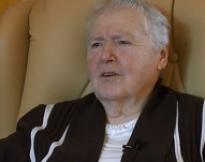Janette

Age at interview: 82
Brief Outline: Janette was diagnosed with gout about seven years ago at the age of 75. She did not want to take medication so she made changes to her diet like eating shellfish less often. She has not had an attack for two years.
Background: Janette is single and lives alone. She is retired, and previously worked as a Counsellor and Trainer. Ethnic background/nationality: White Scottish.
More about me...
Janette had been experiencing pain in her toes for some time, but it gradually got worse and more frequent so she made an appointment to see her GP. The GP diagnosed her with gout. She was surprised to be diagnosed with gout because she has always felt like a healthy person.
Gout attacks stopped Janette from driving, and also limited her social life. She retired from work when she was 80, but before that she was working from home. She occasionally had to reschedule her work, but was mostly able to continue working during attacks although the pain sometimes affected her concentration.
Janette did not want to take medication so she asked her friend to look for some information on the internet about alternative treatments. Her friend printed out some information from the UK Gout Society about diet.
Janette cut out shellfish from her diet, but then had another attack of gout which stopped her from walking. She then looked again at the dietary information and decided to stop eating some other foods. She had two attacks after that but they were less intense.
Janette has continued to ensure that she does not eat certain foods. She does now eats shellfish, but tries to make sure that she does not have it more than twice a week. She has had no attacks in the last two years.
Gout attacks stopped Janette from driving, and also limited her social life. She retired from work when she was 80, but before that she was working from home. She occasionally had to reschedule her work, but was mostly able to continue working during attacks although the pain sometimes affected her concentration.
Janette did not want to take medication so she asked her friend to look for some information on the internet about alternative treatments. Her friend printed out some information from the UK Gout Society about diet.
Janette cut out shellfish from her diet, but then had another attack of gout which stopped her from walking. She then looked again at the dietary information and decided to stop eating some other foods. She had two attacks after that but they were less intense.
Janette has continued to ensure that she does not eat certain foods. She does now eats shellfish, but tries to make sure that she does not have it more than twice a week. She has had no attacks in the last two years.
Janette’s GP came out to see her at home because she could not walk. Her doctor knew her and her history. He examined her foot and diagnosed her with gout.
Janette’s GP came out to see her at home because she could not walk. Her doctor knew her and her history. He examined her foot and diagnosed her with gout.
SHOW TEXT VERSION
PRINT TRANSCRIPT
Well, he examined me. He examined the foot - and my foot, you know, the swollen big toe and bright red and the questions he asked and what-not. They’re all – I’ve always had my feet well looked after. I’m also a diabetic. I’m very peripheral diabetes. I haven’t had a positive test for over ten years, but they do keep looking at your feet [laughs] when you’re a diabetic. And you’re apparently you’re always one if you’ve once been diagnosed. So he knew me and he knew my history. He very quickly said, “It’s gout”. I think I knew by that time that it was gout. In fact, I’m sure I knew [laughs].
Janette says the pain was sharp. She didn’t want anyone near her in case they touched her foot.
Janette says the pain was sharp. She didn’t want anyone near her in case they touched her foot.
SHOW TEXT VERSION
PRINT TRANSCRIPT
So did it affect your sleeping as well?
Yes, yes, because when you turned over.
So was the pain there sort of all the time, but it was worse if you moved it?
If you tried to walk, or, or anything touched it. I was very wary of folk were moving around me, “Don’t come near.” When you see these old, you know, funnies about the old soldiers with – well, the old boozers really, with great bandages around their feet and what-not and yelping if anybody came near them. I’m not surprised, because you don’t want anybody near it.
Janette couldn’t drive during attacks. She worked from home so could continue working as normal most of the time.
Janette couldn’t drive during attacks. She worked from home so could continue working as normal most of the time.
SHOW TEXT VERSION
PRINT TRANSCRIPT
I was just lucky that the kind of thing I was doing was counselling. If I had – if I had gout in my foot, and I was actually doing a session with somebody, I would have to sit and not move. And I could do – I could do that.
With doing that you found that you were able to….
I could concentrate, aye, aye.

